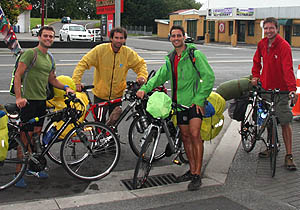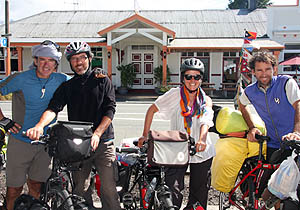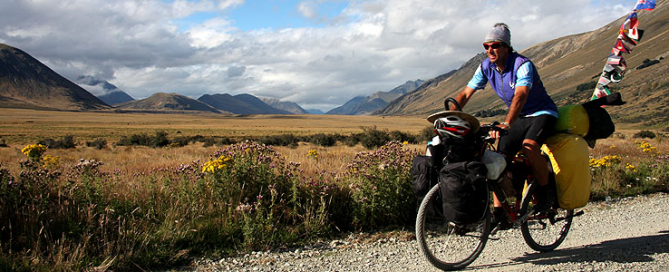April 2, 2012
New Zealand – 101,690 km
I traveled from Sydney to Auckland sponsored by Aerolineas Argentinas. Fortunately, the 107 kg of luggage being carried were free of charge. I have never been so heavy. I had a trailer for the bike and 250 books about my trip that would finance my stay in the new country. I left the airport at 2 am, and while I was looking for a place to camp in its vicinity a Maori policeman stopped me for not wearing a helmet or lights. He immediately reported to the authorities and would not let me go until his boss, a white man, came to me. Just at 4 am on my way to town I found a cemetery where I set up the tent, away from the road and well hidden among trees and tombs.
In the morning, I took the ferry to Waiheke, one of the top destinations to visit from Auckland. There I was welcomed by Francisco or Pancho, an Argentine marine biologist from Curuzu Cuatia, who has came to NZ in a fishing boat 19 years ago, in search of better opportunities. Francisco, who actually works as a fisheries consultant in the Pacific Islands, received me with the style only great travelers have.
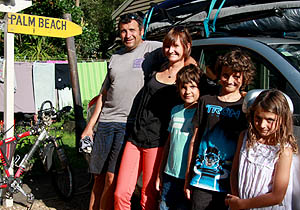

[/one_half]
On the third day, Pancho went on holiday and left me at home alone; as if I was someone he has known forever. During those days I started selling my books at the weekend markets, first in the island and then in Auckland, where Cristina and Lucas welcomed me warmly.
I traveled the North Island for two weeks, with the trailer and half of the books loaded on it. In search of good beaches I went to the Coromandel Peninsula, but that route required a lot of effort from me, I felt as if I was dragging a corpse, and therefore I needed to stop every 100 meters. After a few days I chose to return to the national road, as it was the busiest it was not inconsiderate to the rider. I crossed Hamilton and Cambridge, where I stopped in the markets, and I was even invited by the General Manager of Le Grand Hotel to stay there at no cost for a couple of days. The good man was a native of Bosnia and Herzegovina.
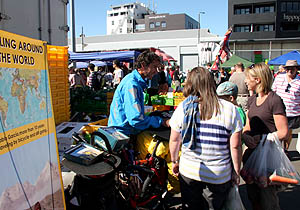

I had several days of rain on my way to Taupo, and having no other option; I had to cross the desert road that goes up to 1000 mt. I felt very sad when I couldn’t find a place to take shelter and, as I was feeling weak, I had to stop to cook lunch and eat underwater. I asked to myself, as few times during my trip, “What the hell am I doing here?” Until just a month ago I had been in Argentina visiting my family where my wanderer qualities obviously had died down, and resuming them was not easy work. The weather was becoming hostile.
During one of those days of constant rain I went into a field that was ruled by someone who looked like a Latino. But Haki was the result of an English-born father with a Maori mother. “The house is full”, he said immediately, but a few minutes of conversation were enough to grant me a space in a warehouse overwhelmed by machinery and tools. He allowed me to use a toilet and even offered me food. The place was just built with wood and veneers; it was a blessing, because it rained all night. There I could stretch my sleeping bag, cook and even set up a kind of desk to work on my computer. In the morning the sky was threatening rain again, and hence I delayed my departure. Haki kept me company and possibly unwittingly gave me a lecture about NZ.
“The first known settlers in New Zealand were Polynesians who, according to most researchers, canoed in the ninth or tenth century. Since then, Polynesian immigrants created a distinct culture now known as Maori. European explorers who began arriving in the seventeenth and eighteenth centuries described the Maoris as a race of bloodthirsty proud warriors. Inter-tribal wars happened frequently during this period. By the nineteenth century, the acquisition of guns by the tribes in contact with the Europeans disrupted the balance of power and led to a period of inter-tribal wars, which ended in the extermination of various tribes and the migration of several others. European settlers also killed a large number of Maoris during this period, and captured slaves and women. It is believed that the Maori population declined by almost 50%. Thus New Zealand became a British colony”.
“After the Second World War, the use of Maori language in schools and workplaces was discouraged, but in recent years there has been a process to preserve the language and culture of the indigenous people of New Zealand. In 1987 it was granted the status of official language. Now there are schools for learning the language and two Maori Television channels”.
“Today many of the typical aspects of New Zealand are derived from the Maori culture. An example of this aspect is the haka, the traditional war song performed by Maori men and now used by the All Blacks”.
The South Island
I came to the South Island with high expectations. During my journey through the North Island and even in Australia I got tired of hearing how great it would be touring the West Coast of the South Island and tour boat in Milford Sound. But at the end of the day I found that many of those people who described the place as impressive, unique or wonderful were only excited and magnifying their experiences.
I found the famous West Coast quite the opposite. The stretch that runs from West Port to Haast, which extends for 450 km, is only a path with dense vegetation that borders the sea at times revealing some of its beaches, where the best of them are adorned with some rocks. In the middle of the ride you can see the two famous glaciers. As I did not fly by helicopter or did not explore them walking, because I had to pay hundreds of NZD, the places did not even brought me a sigh after the effort of walking up to them. It was another day of constant rain. And if I add to this the damn sand flies and the unfriendly people, I dare to say that the West Cost of NZ has been one of my biggest disappointments.
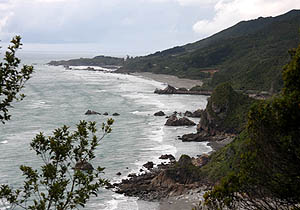
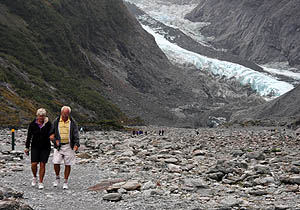
A Maori Legend has it that when one of their goddesses beheld the beauty of southwestern South Island, (now the Fiordland National Park), she was afraid that humans liked it as much as she did and decided to stay and live there, so she sent million of sand flies to expand and make that area their territory. The sand flies are black color microscopic bugs, like mosquitoes but quieter. They bite and suck blood like vampires, hurting. They are everywhere, day and night and always in mass. They don’t left you alone. They attacked each uncovered part of my body, each time I would stop to eat, camp or contemplate the landscape. It was as if the repellent did not exist. There is nothing you can do against them, they are the masters of this land.
I still remember my worst day on the West Coast. As more rain was forecasted, after noon I stopped at the information center of Punakaiki to ask if there was a free place to camp nearby. The person who was in charge asked me what type of vehicle I was traveling in; and when I told him I was traveling by bicycle he told me in a loud and aggressive tone that I could not camp anywhere and that if I did so the police would find me and make me pay a fine of 200 NZD. Only those traveling with a vehicle and their own bathroom can camp for free. Although the country has several campsites with bathrooms, there was none in that area.
I kept pedaling as much as I could that evening, and as soon as the rain reached me I stopped at a barn that had its door open. I needed to eat something and make time. After 10 minutes the owner came after me, asked me some questions and asked me to leave. That afternoon the rain did not give me respite. I was completely soaked and could find no place to stop.
With the last light of the day I went through a village and went to one of its last houses, where there was a huge barn. There was a TV on and a woman watching it. I approached the window and after I tidied up my hair a bit, I called her while being away from the window. The woman quickly disappeared when she saw me. I thought she was putting on a coat, but I waited and called her for several minutes and she never appeared. Instead, she sent her dog, a Pekingese, and with the rage I had been building up I would have given it a kick and hung it in the fireplace. It had not been a good day, I only needed to end up in police custody, I thought. So I gave a deep breath and kept pedaling in the rain….
At night, after 107 km, I spotted a rugby field in another town and as there was no one I took refuge under a porch. It seemed to be the perfect place. After I was settled and I finished dinner a guy came in his car to ask for cigarettes. He was drunk and ended up being very annoying. After 15 minutes I decided to leave because his car would not start. It was 11 pm and I had to find another place to camp in the rain. I was furious. When I finally started to set up the tent, I noticed that it was on the stool of an animal …. “My God, definitely not my day today,” I thought. But then I heard the inveterate engine of the drunkard’s car and I returned to the rugby field, where I eventually spent the night. The next day I pedaled another 15 km in the rain and without hesitation I went to a hotel. I needed to rest.
I had several disappointments like that throughout the country. But I appreciate Patrick in Wellington, Tony in Nelson, Kevin in Hokitika and Richard in Christchurch who are bicycle travelers and as good members of Warmshower.org welcomed me in their homes.
Fortunately during the last three weeks of my stay in NZ it rained less and, although it was only for a couple of days and just a few hours, I could pedal under the sun. The most beautiful and worthwhile routes in my opinion are Haast-Queenstown, Queenstown-Mavora Lake, Te Anau-Milford Sound and Queenstown-Tekapo Lake.
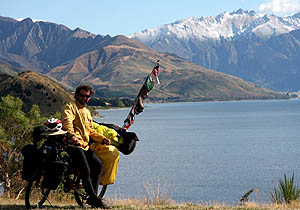
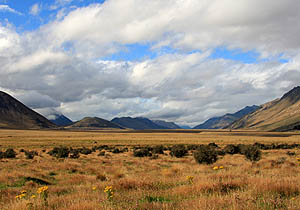
I thank all the Latinos who work in NZ with the working visa or not, and needed just seconds to open the doors of their home and make me feel like lifelong friends. Thanks to Tomas from Argentina in Wellington, Xushua and Tarek from Brazil and Ines from Argentina in Queenstown, Cecilia and Pablo from Argentina in Te Anau and Milford, Nico and Ana from Chile and Spain in Lumsden, and Fede and Angie from Argentina in Hindis. Also thanks to Maria from the Philippines in Palmerston North, and Andy from Argentina in Christchurch for taking me to the airport with such a big luggage.
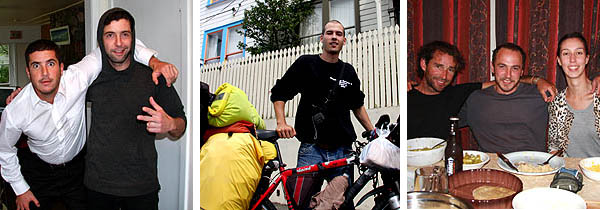
I also thank the bicycle travelers who shared the route with me, or just a good night’s camping. Thanks to Giovanni, Andrea and Jocham that cycled NZ from end to end, thanks to Nuno and Joana who started their New Zealand-Portugal trip, and Alvaro Biciclown, who I met by fourth time on my whole trip.
New Zealand, a real adventure!
